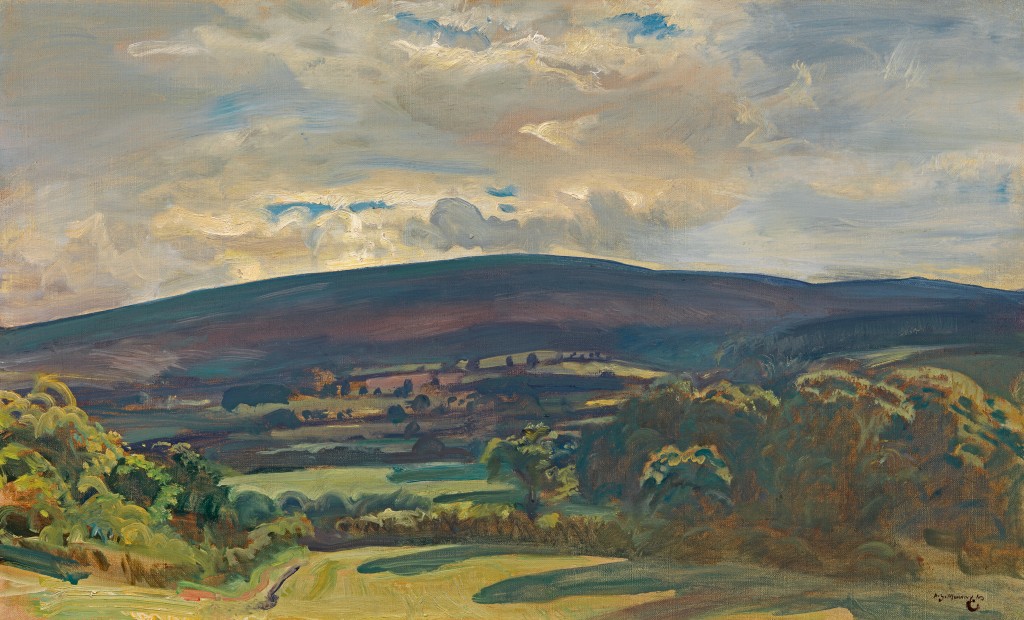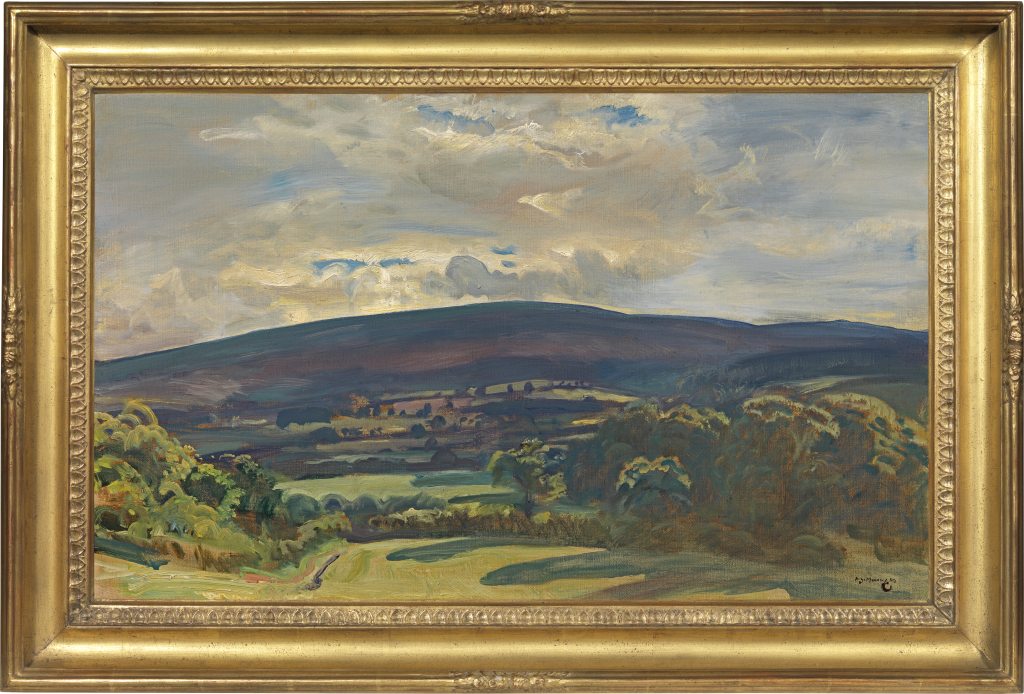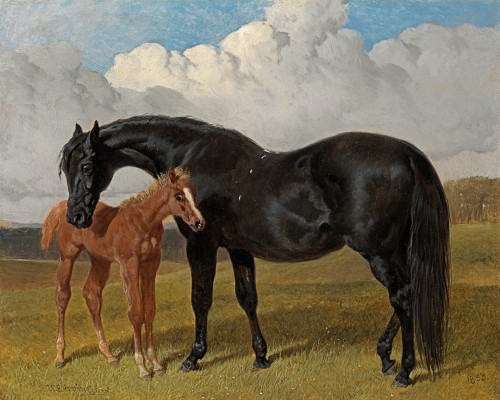SIR ALFRED MUNNINGS
Mendham 1878 - 1959 Dedham
Ref: BZ 134
View from Selworthy, Exmoor
Signed lower right: A.J. Munnings
Oil on canvas: 17 3/8 x 28 1/8 in / 44.1 x 71.4 cm
Frame size: 22½ x 33½ in / 57.2 x 85.1 cm
Painted in the 1940s
Provenance:
The Leicester Galleries, London (Ernest Brown & Phillips Ltd.), where purchased in 1947 by
Miss Sybil Harker (1902-1985), Wacton Hall, Long Stratton, Norfolk;
by descent in a private collection, UK
Exhibited:
London, Leicester Galleries, Sir Alfred J Munnings, PRA, November 1947, no.29
In the 1920s Alfred Munnings’s second wife, Violet, who was a superb equestrienne, bought a cottage, ‘Riverside’, at Withypool in Somerset. She hunted on Exmoor with the Devon and Somerset Staghounds, enjoying more challenging terrain than the hunting in East Anglia. In 1940 Munnings’s home, Castle House at Dedham in Essex was requisitioned by the Army and he moved to Withypool, finding a curious freedom in the midst of conflict by painting pure landscape, unburdened by irksome commissions. Munnings wrote lyrically of Exmoor: ‘In the spring white blackthorn blossom, and later the hawthorn. With glistening stalks of dead bracken around, and young green fronds uncurling through ... bluebells a faint mist on the slope, and songs of blackbird and thrush in the air, I have sat in the shadow of an aged thorn in blossom, painting massed white blossoming trees below, casting their shadows on the hillside and their scent all around. Farther below still, the gleam of a small stream rippling over stones in the sun, its sweet, silvery music ascending, mingling with the blackbird’s song’[1].
This work depicts a favourite motif which Munnings painted frequently before and during the Second World War, the view from Selworthy on the northern side of Exmoor, about eight miles from Withypool. The open-ended composition gives the exhilarating sense of space that Munnings so treasured when staying in this part of the England. He captures the bright greens of the summer trees and agricultural land in the valley, rising to the deep purple of the moorland, shadowed by clouds. The long crest of the moor stands out sharply against the rich, buttery-yellow light breaking on the horizon. Munnings spent countless days capturing the endlessly changing configuration of clouds and the shadows that raced across the undulating landscape. The grandeur and palette of the scenery was very different from the lush watermeadows and gentle light of his East Anglian home.
This painting was acquired by Miss Sybil Harker (1902-1985) at the Leicester Galleries in 1947. It was a present to her from the members of the Norwich Staghounds in appreciation for her work as Master of the Hunt from 1932 to 1945. In fact she remained as Master until the demise of the Staghounds in 1963[2]. There had been a tradition of hunting carted deer in Norfolk since the late eighteenth century. Munnings hunted with the Norwich Staghounds from before the First World War, noting that the members comprised ‘a cavalcade of farmers, a doctor or two, a squire or two, a butcher, perhaps, a veterinary, some hard riding ladies’[3]. ‘Unlike a fox hunt, they go on and on if a good deer is out’: thirty-mile runs and twenty-mile points were frequent.
Sybil Harker was the daughter of Margaret and William Harker and the granddaughter of Archibald Coats, the wealthy owner of mills making cotton thread. She grew up at Blofield Hall, east of Norwich. She was a lifelong friend of Munnings, who made a magnificent painting of her in the 1930s, Sybil Harker on Saxa, with the Norwich Staghounds (private collection)[4]. In the third volume of his autobiography, The Finish, Munnings describes a telephone call from Sybil asking him to stay at Wacton, just as he is writing about her celebrated huntsman, Tom Thackeray: ‘Sybil Harker…a tall, swell girl – still a girl for me – who for years had been Master of the hounds which Thackeray hunted…Hearing that soft, full contralto, I saw her as she sat for me long ago on her horse. She was tall and dark, wearing a dark blue habit and a black velvet cap…Thackeray, with the hounds, in the background, the tall, twin towers of Wymondham Church in the distance’[5].
SIR ALFRED MUNNINGS, PRA, RWS
Mendham 1878 - 1959 Dedham
Born in Mendham, Suffolk, Alfred Munnings was the son of a miller. He was apprenticed to a firm of lithographers from 1893 to 1898 and studied at the Norwich School of Art and in Paris. There he was impressed with plein-air naturalism; this, together with his introduction to the racecourse in 1899, influenced the themes for which he became famous.
While in Mendham, Munnings painted many scenes of country life, particularly horse fairs. He went to Cornwall in 1908, and for many years was an important addition to the Newlyn School of artists. When the First World War broke out, Munnings enlisted, despite having the use of only one eye owing to an accident in 1899. He became an army horse trainer near Reading and later went to France as an official war artist, attached to the Canadian Cavalry Brigade.
The year 1919 was a major turning-point in all aspects of Munnings’s life; he painted his first racehorse, Pothlyn, the winner of the Grand National, and became an Associate of the Royal Academy. He met Violet McBride, whom he was to marry, and bought Castle House, Dedham, where the Munnings Memorial Trust maintains a permanent exhibition of his pictures. Munnings’s prolific career, spanning over sixty years, brought him honour, with election to the Presidency of the Royal Academy in 1944, a Knighthood in 1945, and a personal award from the Sovereign in 1947, when he was created Knight of the Royal Victorian Order.
[1] Sir Alfred Munnings, The Finish, London 1952, p. 105.
[2] JNP Watson, British and Irish Hunts and Huntsmen, vol. III, pp.62-63.
[3] Sir Alfred Munnings, An Artist’s Life, London 1950, p.257.
[4] Sold at Christie’s New York, 6th December 2000, lot 90.
[5] London 1952, p.319.































